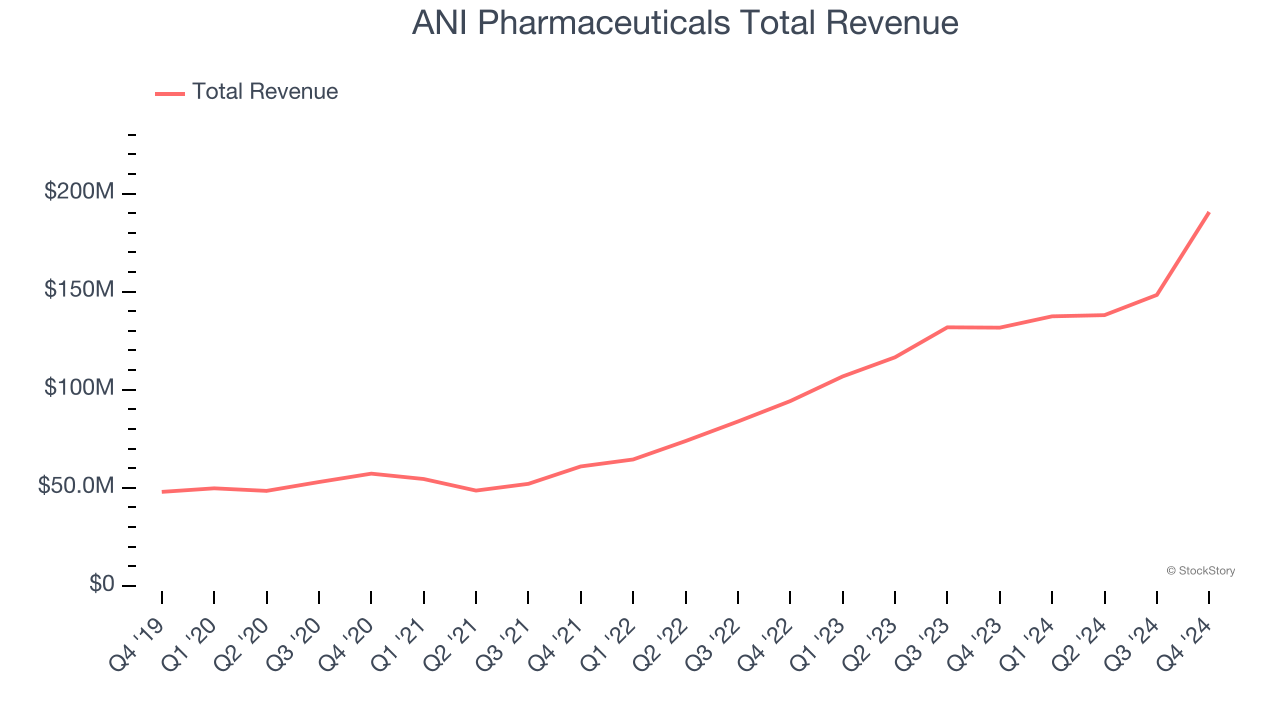
Earnings results often indicate what direction a company will take in the months ahead. With Q4 behind us, let’s have a look at Jazz Pharmaceuticals (NASDAQ: JAZZ) and its peers.
The pharmaceuticals sector is pivotal in the development, manufacturing, and distribution of drugs and treatments across a wide range of therapeutic areas. These companies benefit from diversified portfolios, including blockbuster drugs, vaccines, and specialty treatments, along with the ability to generate substantial revenue from both branded and generic medications. Advantages include large-scale manufacturing capabilities, significant resources for research and development, and the ability to generate revenue from multiple channels. However, challenges include patent expirations leading to generic competition, high regulatory hurdles, and the inherent risk of drug development failure in clinical trials. Looking ahead, the pharmaceuticals sector is poised to benefit from several strong tailwinds. Innovations in precision medicine, including genetic therapies and advanced biologics, should drive growth, particularly in oncology, rare diseases, and chronic conditions. The increasing role of artificial intelligence in drug discovery and patient care is another key to better, more efficient drug development. However, the sector also faces potential headwinds like regulatory pressure on drug pricing, with patients and the government on both sides of the political divide in the US agreeing that consumers are spending too much on healthcare. There is also the growing scrutiny of patent practices to protect consumers as well as evolving competition from biosimilars.
The 17 pharmaceuticals stocks we track reported a mixed Q4. As a group, revenues beat analysts’ consensus estimates by 1.7%.
Amidst this news, share prices of the companies have had a rough stretch. On average, they are down 12.1% since the latest earnings results.
Jazz Pharmaceuticals (NASDAQ: JAZZ)
Originally founded in 2003 and now headquartered in Ireland following a 2012 tax inversion merger, Jazz Pharmaceuticals (NASDAQGS:JAZZ) develops and markets medicines for sleep disorders, epilepsy, and cancer, with a focus on treatments for patients with limited therapeutic options.
Jazz Pharmaceuticals reported revenues of $1.09 billion, up 7.5% year on year. This print exceeded analysts’ expectations by 2.8%. Overall, it was a strong quarter for the company with a solid beat of analysts’ full-year EPS guidance estimates.

The stock is down 26.8% since reporting and currently trades at $102.20.
Is now the time to buy Jazz Pharmaceuticals? Access our full analysis of the earnings results here, it’s free.
Best Q4: ANI Pharmaceuticals (NASDAQ: ANIP)
With a diverse portfolio of 116 pharmaceutical products and a growing rare disease platform, ANI Pharmaceuticals (NASDAQ: ANIP) develops, manufactures, and markets branded and generic prescription pharmaceuticals, with a focus on rare disease treatments.
ANI Pharmaceuticals reported revenues of $190.6 million, up 44.8% year on year, outperforming analysts’ expectations by 8.5%. The business had a stunning quarter with an impressive beat of analysts’ full-year EPS guidance estimates and full-year revenue guidance exceeding analysts’ expectations.

ANI Pharmaceuticals delivered the fastest revenue growth among its peers. The market seems happy with the results as the stock is up 24.3% since reporting. It currently trades at $67.85.
Is now the time to buy ANI Pharmaceuticals? Access our full analysis of the earnings results here, it’s free.
Weakest Q4: Viatris (NASDAQ: VTRS)
Created through the 2020 merger of Mylan and Pfizer's Upjohn division, Viatris (NASDAQ: VTRS) is a healthcare company that develops, manufactures, and distributes branded and generic medicines across more than 165 countries worldwide.
Viatris reported revenues of $3.53 billion, down 8.1% year on year, falling short of analysts’ expectations by 1.8%. It was a disappointing quarter as it posted full-year revenue guidance missing analysts’ expectations.
Viatris delivered the slowest revenue growth in the group. As expected, the stock is down 33.9% since the results and currently trades at $7.42.
Read our full analysis of Viatris’s results here.
Bristol-Myers Squibb (NYSE: BMY)
With roots dating back to 1887 and a transformative merger in 1989 that gave the company its current name, Bristol-Myers Squibb (NYSE: BMY) discovers, develops, and markets prescription medications for serious diseases including cancer, blood disorders, immunological conditions, and cardiovascular diseases.
Bristol-Myers Squibb reported revenues of $12.34 billion, up 7.5% year on year. This print surpassed analysts’ expectations by 6.6%. Aside from that, it was a mixed quarter as it also logged an impressive beat of analysts’ EPS estimates but a significant miss of analysts’ full-year EPS guidance estimates.
The stock is down 17.1% since reporting and currently trades at $49.45.
Read our full, actionable report on Bristol-Myers Squibb here, it’s free.
Merck (NYSE: MRK)
With roots dating back to 1891 and a portfolio that includes the blockbuster cancer immunotherapy Keytruda, Merck (NYSE: MRK) develops and sells prescription medicines, vaccines, and animal health products across oncology, infectious diseases, cardiovascular, and other therapeutic areas.
Merck reported revenues of $15.62 billion, up 6.8% year on year. This result topped analysts’ expectations by 1.3%. Aside from that, it was a slower quarter as it produced full-year revenue guidance missing analysts’ expectations.
Merck had the weakest full-year guidance update among its peers. The stock is down 23.1% since reporting and currently trades at $76.77.
Read our full, actionable report on Merck here, it’s free.
Market Update
In response to the Fed’s rate hikes in 2022 and 2023, inflation has been gradually trending down from its post-pandemic peak, trending closer to the Fed’s 2% target. Despite higher borrowing costs, the economy has avoided flashing recessionary signals. This is the much-desired soft landing that many investors hoped for. The recent rate cuts (0.5% in September and 0.25% in November 2024) have bolstered the stock market, making 2024 a strong year for equities. Donald Trump’s presidential win in November sparked additional market gains, sending indices to record highs in the days following his victory. However, debates continue over possible tariffs and corporate tax adjustments, raising questions about economic stability in 2025.
Want to invest in winners with rock-solid fundamentals? Check out our Top 6 Stocks and add them to your watchlist. These companies are poised for growth regardless of the political or macroeconomic climate.
Join Paid Stock Investor Research
Help us make StockStory more helpful to investors like yourself. Join our paid user research session and receive a $50 Amazon gift card for your opinions. Sign up here.






